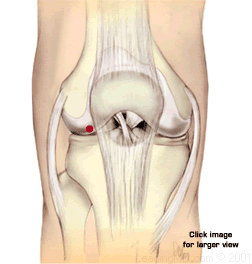|
 |
Operative
Treatment
Patients for whom surgery is generally recommended:
It is important to consider the
patient's commitment to the rehabilitation program following
an ACL surgical procedure. This is especially critical if a
meniscal repair is also required. The patient must agree to
carefully follow the recovery timetable outlined by the doctor. |
The timing of an operation is important
to prevent stiffness after surgery and obtain the best results.
It is helpful when:
- range of motion is adequate
- swelling is reduced
- quadricep muscles are functional
It
often takes about three weeks for the knee to reach this point.
Is there a simple way to repair the damaged ACL without
a reconstruction?
In a direct repair the ends of the torn ligament are
sewn together. This procedure is usually not recommended, as the ends
of the ligament do not heal reliably. Direct repairs of the ligament
to the bone may heal; however, this, also is not always reliable.
Extra-articular (outside the joint) procedures involve
securing a portion of a tendon on the outer part of the knee (the
iliotibial band) across the outside of the joint. This
procedure does not reconstruct the torn ACL. It attempts to provide
increased stability by placing a restraint on the outside of the knee.
This procedure is generally not adequate by itself but it is occasionally
done to provide additional support after ACL reconstruction.
Replacing the damaged ACL with a graft made of synthetic
materials is no longer performed due to poor results. Many patients
who had this surgery experienced reactions to the synthetic material
as well as early failures of the graft.
An ACL reconstruction is the most common surgical
procedure performed today since it usually produces the best results.
 
© 2015 by LeadingMD.com All rights reserved.
Disclaimer
|
|
Stem cells, PRP, and HA, oh my! We are not in Kansas anymore… Part 2
READ MORE >>
|
|
|
|

